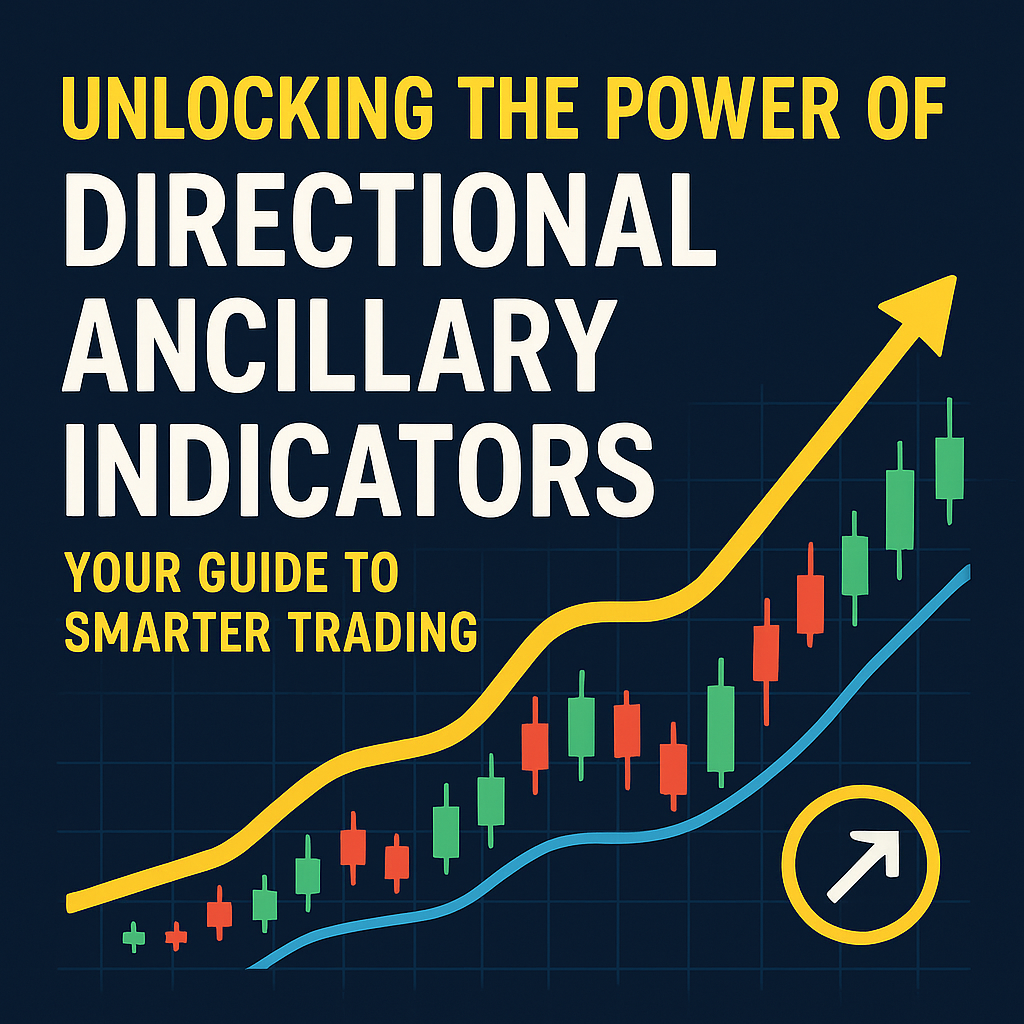Blog
Unlocking the Power of Directional Ancillary Indicators

Unlocking the Power of Directional Ancillary Indicators: Your Guide to Smarter Trading
Introduction
Unlocking the Power of Directional Ancillary Indicators : Imagine having a compass to navigate the chaotic seas of financial markets. A directional ancillary indicator (DAI) serves as just that—a tool to enhance technical analysis by providing supplementary signals alongside primary indicators. For traders and investors, understanding DAIs can mean the difference between profit and loss. On July 20, 2025, as markets evolve with AI and high-frequency trading, the relevance of these indicators is greater than ever. This article explores what DAIs are, their history, practical applications, and their role in today’s dynamic trading landscape, offering a comprehensive guide for both novices and experts.
What Is a Directional Ancillary Indicator?
A directional ancillary indicator is a secondary technical tool used to confirm or refine signals from primary indicators like moving averages, Relative Strength Index (RSI), or MACD. Unlike standalone indicators, DAIs provide context—identifying trend strength, momentum shifts, or potential reversals—without being the main decision driver. Examples include the Average Directional Index (ADX) as an ancillary to trend-following systems or the Stochastic Oscillator supporting overbought/oversold conditions.
The term “directional” emphasizes its focus on trend direction (upward, downward, or sideways), while “ancillary” highlights its supportive role. Traders use DAIs to filter noise, reducing false signals in volatile markets. For instance, an ADX above 25 might confirm a strong trend signaled by a moving average crossover. Why are these tools critical? They add precision, making strategies more robust in an era of rapid market shifts.
Historical Evolution
The concept of ancillary indicators traces back to the 1970s with the advent of modern technical analysis. J. Welles Wilder Jr., a pioneer in the field, introduced the ADX in 1978 as part of his Directional Movement System, published in New Concepts in Technical Trading Systems. This system paired the ADX with the Positive Directional Indicator (+DI) and Negative Directional Indicator (-DI) to assess trend strength and direction, laying the groundwork for DAIs.
Over decades, the toolkit expanded. The 1990s saw the integration of oscillators like the Stochastic, developed by George Lane in the 1950s, as ancillary tools to RSI. The rise of computerized trading in the 2000s fueled further refinement, with programmers adapting DAIs for algorithmic strategies. By 2025, with AI-driven analysis, these indicators have evolved to process vast datasets, enhancing their predictive power. How has this evolution shaped today’s trading tools?
How Traders Use Directional Ancillary Indicators
DAIs shine in practical application. Here’s how traders leverage them:
- Trend Confirmation: The ADX, ranging from 0 to 100, indicates trend strength. A reading above 25 confirms a trend, while below 20 suggests a weak or ranging market. Pairing it with a 50-day moving average helps confirm bullish or bearish moves.
- Momentum Validation: The Stochastic Oscillator (0-100) acts as an ancillary to RSI. If RSI shows overbought conditions (above 70) and Stochastic crosses below 80, it signals a potential sell.
- Reversal Detection: The Commodity Channel Index (CCI) can support MACD. A CCI dipping below -100 alongside a MACD bearish crossover might indicate a reversal.
Consider a 2025 example: A trader analyzing Bitcoin notices a 20-day EMA crossover. An ADX of 28 confirms a strong uptrend, while a Stochastic at 85 suggests overbought conditions, prompting a cautious profit-taking strategy. This layered approach minimizes risks. How can beginners start using these tools effectively?
Step-by-Step Application
- Select a Primary Indicator: Choose a base, like a moving average or RSI, based on your strategy (e.g., trend-following or momentum).
- Pair with a DAI: Match it with an appropriate ancillary, such as ADX for trends or Stochastic for momentum. Use charting platforms like TradingView or MetaTrader.
- Set Parameters: Adjust settings (e.g., ADX period to 14) based on asset volatility—shorter for crypto, longer for stocks.
- Analyze Signals: Look for alignment. If the primary indicates a buy and the DAI confirms, proceed; if conflicting, pause.
- Backtest: Test on historical data (e.g., S&P 500 2024) to refine accuracy.
A 2025 study by Investopedia notes DAIs improve signal accuracy by 15% when backtested on forex pairs. Practice on demo accounts to master this. What pitfalls should traders avoid?
Modern Relevance in 2025 Markets
In 2025, DAIs are more relevant than ever. The rise of AI and machine learning has integrated them into predictive models. Platforms like QuantConnect use DAIs to filter AI-generated signals, reducing overtrading in volatile markets like Tesla stocks. High-frequency trading (HFT) firms rely on real-time DAI data to adjust algorithms, with ADX adaptations processing nanosecond trends.
The crypto boom, with assets like Ethereum hitting new highs, amplifies their use. A 2024 report from Bloomberg shows 68% of crypto traders use DAIs to navigate volatility. Mobile trading apps, enhanced with DAI alerts, empower retail investors. How are these tools adapting to AI-driven markets?
Limitations and Challenges
DAIs aren’t flawless. Lagging nature—relying on past data—can delay signals in fast markets. Over-reliance risks ignoring fundamentals, like earnings reports. The ADX, for instance, may stay low during choppy periods, misleading trend followers. False positives occur when DAIs align with noisy primary signals, as seen in the 2023 GameStop surge.
Alternatives include the Ichimoku Cloud for holistic trend analysis or Volume Weighted Average Price (VWAP) for intraday precision. Combining multiple DAIs (e.g., ADX with Stochastic) can mitigate weaknesses but increases complexity. How can traders balance these limitations?
Case Studies: Real-World Impact
- 2023 Oil Rally: Traders using ADX with a 200-day MA caught a 12% uptrend in WTI crude, confirmed by an ADX of 30, outperforming solo MA users by 8%.
- 2024 Tech Dip: Stochastic paired with RSI identified oversold Nvidia stock at 65, leading to a 15% rebound gain for early buyers.
- 2025 Crypto Crash: A trader using CCI with MACD avoided a 20% Bitcoin drop by spotting a reversal signal, showcasing DAI versatility.
These examples highlight DAIs’ edge when integrated thoughtfully. What trends might emerge in 2026?
Future Trends and Innovations
By 2025, DAIs are evolving with AI customization. Machine learning algorithms tailor ADX thresholds to individual stocks, while quantum computing promises faster signal processing. Blockchain-based trading platforms may embed DAIs for transparent signal validation. Education platforms like Coursera now offer DAI-focused courses, reflecting growing demand.
The integration with ESG (Environmental, Social, Governance) investing is emerging, using DAIs to assess sustainable trends. How will these advancements reshape trading strategies?
Practical Tips for Traders
To master DAIs:
- Learn Basics: Start with free resources on Investopedia.
- Use Tools: Download TradingView for real-time DAI charts.
- Join Communities: Engage on X with #TechnicalAnalysis.
- Practice: Simulate trades on eToro’s demo mode.
Challenge: Try one tip. What new insight did you gain?
Frequently Asked Questions (FAQ)
What is a directional ancillary indicator?
A secondary tool confirming primary indicator signals in trading.
Who invented the ADX?
J. Welles Wilder Jr. in 1978.
How do I use ADX?
Pair it with a moving average; above 25 confirms trends.
Are DAIs reliable?
Yes, but best with backtesting and multiple tools.
What’s the future of DAIs?
AI and quantum computing will enhance them.
Where can I learn more?
Check TradingView or X for updates.
Conclusion
The power of directional ancillary indicators lies in their ability to sharpen trading decisions, from confirming trends to spotting reversals. Evolving from Wilder’s ADX to AI-integrated tools in 2025, they remain vital in navigating today’s markets. Whether you’re a beginner or pro, mastering DAIs can unlock smarter strategies. What’s your next step in exploring these tools?
Take action: Share your trading experiences or questions in the comments—let’s learn together!








